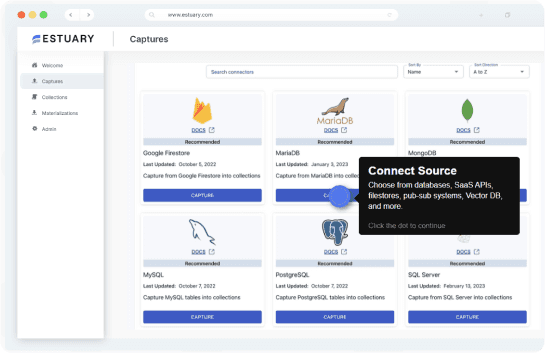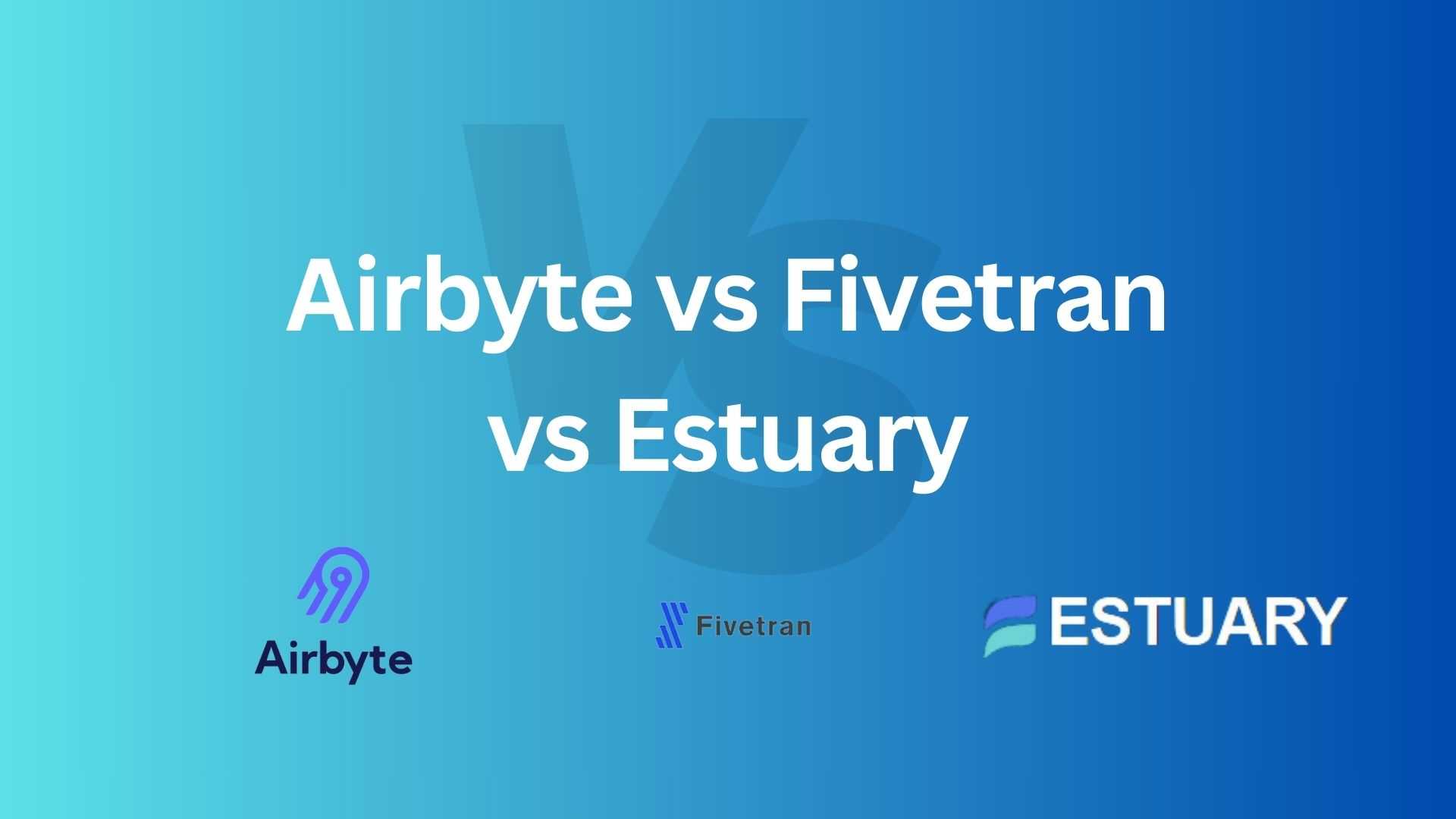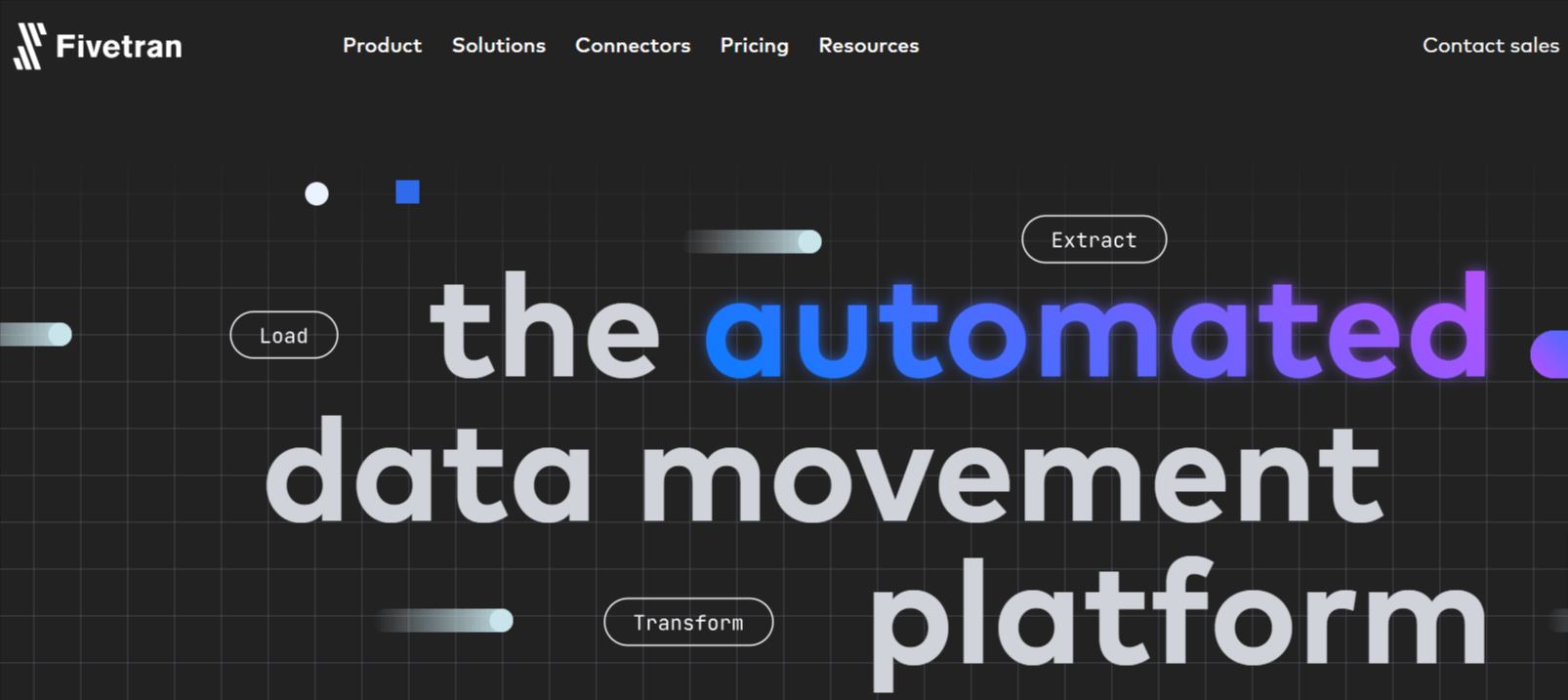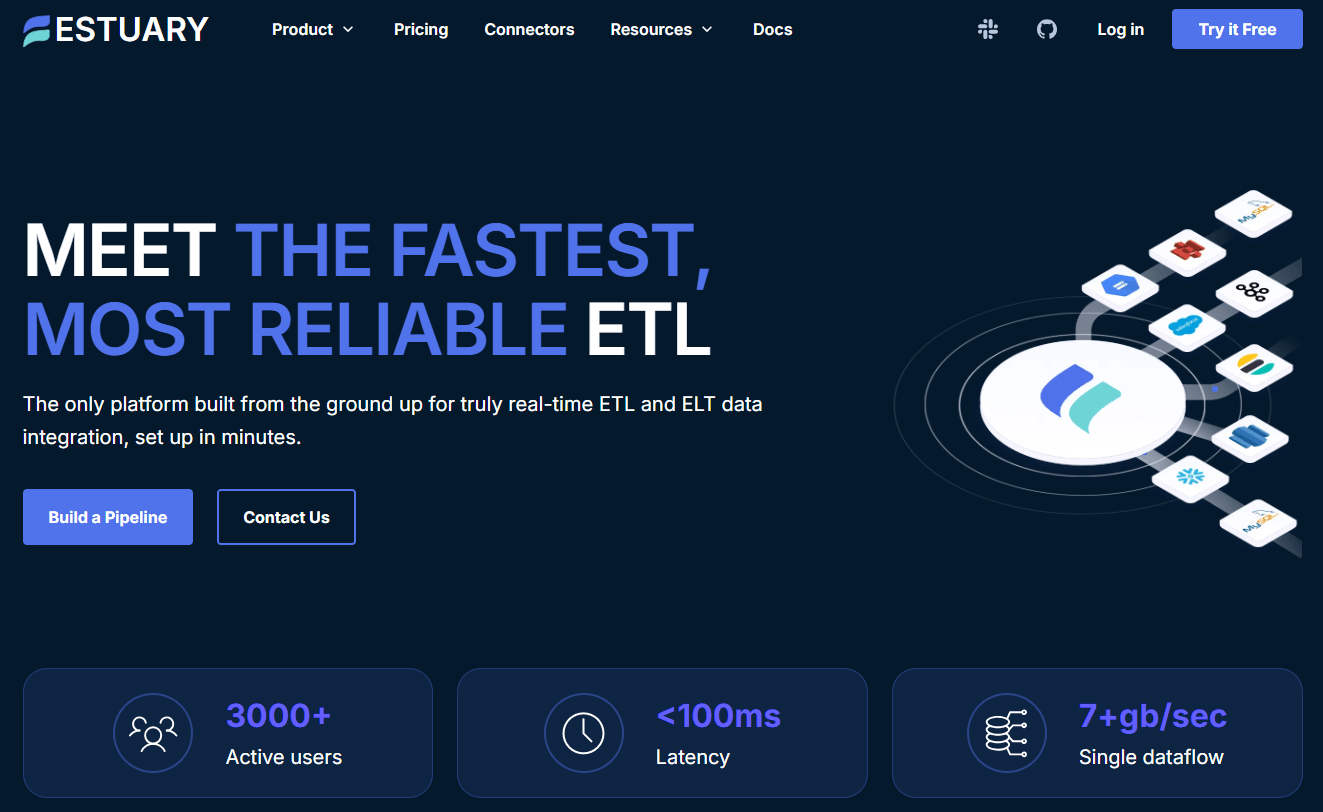If you’re implementing a cloud data warehouse, you’re probably evaluating cloud ELT (Extract, Load, and Transform) tools to help you build modern data pipelines. Airbyte and Fivetran are two of the most widely used ELT tools on the market today.
When evaluating Airbyte vs. Fivetran, it’s important for you to compare them based on your use cases, core features, performance, scalability, reliability, support, and the total cost of ownership. You also need to compare them against modern real-time ETL vendors like Estuary.
This in-depth 2024 comparison of Airbyte vs Fivetran vs Estuary will help you understand the strengths, weaknesses, and unique offerings of each platform, and help guide you to the best choice based on your specific data integration needs.
Introduction to Airbyte, Fivetran, and Estuary
Before diving into the detailed comparison, let’s start with a summary of each platform.
What is Airbyte?
Airbyte is an open-source ELT platform founded in 2020, originally as a Singer-based framework. They have since moved away from the Singer protocol but still support Singer connectors. They currently only support 50 native connectors; the rest come from their open source marketplace.
They later released their cloud service in 2022. Despite being a relatively new entrant in the market, Airbyte has quickly gained popularity as an open-source option. While it is one of the lower cost options, it only supports batch-based ELT, with transforms being done using external tools like dbt (Data Build Tool). It is also not as scalable or reliable as some others like Estuary or Fivetran.
- Founded: 2020
- Headquarters: San Francisco, California
- Unique Selling Point: Open-source or cloud, with a library of open source connectors.
What is Fivetran?
Fivetran was originally founded in 2012, and after a few years began to focus just on data integration. In 2020 it integrated dbt core into its SaaS offering, and started to add change data capture (CDC). Today it is one of the more widely used ELT tools for data integration in the market.
Fivetran has several strengths including its ease of use, number of native and lite (API) connectors, its scalability, and reliability. It also has many features you’d expect in a more mature platform, including various load options. But it is the most expensive ELT tool on the market. Several complain about high, unpredictable costs, in part due to how it measures monthly active rows (MAR). It is also, like most other ELT tools, batch-only ELT that can only load one destination at a time. If you need to lower latency or load multiple destinations you’ll need to look elsewhere.
- Founded: 2012
- Headquarters: Oakland, California
- Unique Selling Point: Easy-to-useSaaS ELT with a large number of connectors that’s reliable and scales.
Learn more: What is Fivetran and how its works?
What is Estuary? Alternative to Airbyte and Fivetran
Estuary, founded in 2019, offers a modern real-time CDC and ETL SaaS platform, Estuary Flow, which stands out because it’s one of the few real-time data integration platforms. It’s built on the Gazette open source project, technology that has been evolving for over a decade in the Ad Tech space, which has been a source of many cutting-edge real-time data technologies.
Estuary Flow supports both real-time and batch sources and destinations, which makes it a great choice not just for real-time data pipelines, but for support more than just data warehouses.
Some of its biggest strengths include its ease of use, with the ability to create new pipelines in minutes, strong real-time and batch connectivity, ETL and ELT support, scalability, reliability, and support. It has the only real-time CDC support, which ends up making it more reliable as well, and is also the lowest cost vendor even among other ELT vendors.
Perhaps its only weaknesses are fewer native connectors than Fivetran, and not as many deployments. But it is rapidly catching up in both.
- Founded: 2019
- Headquarters: New York, New York
- Unique Selling Point: Real-time CDC, real-time and batch ETL and ELT, performances scalability, and low cost.
Airbyte vs Fivetran vs Estuary: Key Features Overview
The table below provides a snapshot of the key features across Airbyte, Fivetran, and Estuary Flow, setting the stage for a deeper exploration of each platform’s capabilities.
| Feature | Airbyte | Fivetran | Estuary |
|---|---|---|---|
| Latency | Batch (minutes+) | Batch (minutes+) | Real-time (sub-100ms) or batch (seconds+) |
| Connectors | 50+ maintained connectors, 300 marketplace connectors | <300 connectors 300+ lite (API) connectors | 150+ high performance connectors built by Estuary |
| Support for 3rd party connectors | Yes (Singer/Stitch connectors) | No | Support for 500+ Airbyte, Stitch, and Meltano connectors |
| Custom Connector | Yes | Yes (custom function and hosted Lite connectors) | Yes |
| Sync Data Frequency | Unlimited | Restricted per tier | Unlimited |
| CLI Support | Yes (Octavia) | No (HVR only) | Yes |
| API Availability | Yes | Yes | Yes |
| Scalability | Low-Medium Lack of source scaleout | Medium-High HVR is high scale | High 5-10x scalability of others in production |
1. Pipeline latency: Airbyte vs Fivetran vs Estuary
How data is moved and processed through a data pipeline is a critical factor in choosing the right data integration platform. Each vendor in this comparison ends up having very different latency, scalability, and reliability for data processing and data synchronization.
Airbyte: Batch CDC and ELT
Airbyte primarily uses batch for extracting and loading data. This includes its support for CDC, which is based mostly on Debezium. for For any incremental extractions, including CDC, Airbyte will extract changes in batch intervals.. Airbyte five combinations of incremental/full, and refresh/append modes with deduplication in part because its CDC is at least once delivery:
- Full Refresh – Overwrite: All data is re-synced from the source, completely overwriting existing records.
- Full Refresh – Append: All data is re-synced from the source, appending to existing records.
- Full Refresh – Overwrite+Deduped: overwrite existing data, and dedupe before writing.
- Incremental – Append: Only new or modified data is synced, appending to existing records.
- Incremental – Append + Deduped: Only new or modified data is synced, with duplicate rows merged before writing.
For all of these combinations, Airbyte is append only, not update in place. Overwrite is really a full delete of the table before appending. Related to this, Airbyte only does soft deletes in the destination where it appends a new row with the delete state. It does not delete a row in the destination (unless you do a full refresh.)
Batch processing works well with cloud data warehouses unless you need to lower latency. In that case other options including Estuary may make more sense.
Fivetran: Batch CDC and ELT
Fivetran also uses batch processing for CDC and ELT..
Like Airbyte, even though Fivetran uses CDC, it reads change data in batch intervals. This not only adds latency. It also puts additional load on the source database, which in some cases can cause source failures. For more, read Change Data Capture (CDC) Done Correctly (CDC)..
Estuary Flow: Real-time Streaming and Batch
Estuary Flow support both real-time data processing and batch. With real-time, change data or messages are extracted as soon as they occur, with sub-100ms latency, and both streamed and stored by Estuary.. Estuary Flow’s architecture supports both real-time and batch data, but its strength lies in its ability to deliver changes to multiple destinations almost instantly.
- Advantages of Estuary Flow’s Real-Time Processing:
- Low Latency: Data updates are sub-100ms .
- Scalability: Scales elastically for both streaming and batch, proven to 7GB+/sec with a single pipeline..
- Flexibility: Can work with both batch-based and real-time data sources and destinations.
Category Winner: Estuary Flow
Estuary Flow’s real-time and batch processing capabilities make it the clear leader in this category, offering unparalleled speed and efficiency for data integration.
2. Data Connectors: Airbyte vs Fivetran vs Estuary
The availability and flexibility of data connectors are crucial in determining a data integration platform’s versatility. Connectors are standardized and pluggable components used to interface with various data systems, enabling the flow of data between them.
| Connectors | Airbyte | Fivetran | Estuary |
| Number of connectors | 50+ maintained connectors, 300 marketplace connectors | <300 connectors 300+ lite (API) connectors | 150+ high performance connectors built by Estuary |
| Streaming connectors | Batch CDC only. Batch Kafka, Kinesis (destination only) | Batch CDC only. Batch Kafka & Kinesis both source only. | Streaming CDC, Kafka, Kinesis (source only) |
| Support for 3rd party connectors | Yes (Singer connectors) | No | Support for 500+ Airbyte, Stitch, and Meltano connectors |
| Custom | Yes | Yes | Yes |
| SDK | Yes (custom function and hosted Lite connectors) | Yes (adds new 3rd party connector support fast) | |
| API (for admin) | Yes | Yes Fivetran Rest API docs | Yes Estuary API docs |
Airbyte: Extensive Open-Source Connectors
Airbyte has 350+ connectors, but only 50+ of them are actively maintained by Airbyte. The rest are open source connectors list in its Marketplace. It does also support Singer connectors.
- Custom Connector Support: Airbyte has good options for adding connectors, from its connector builder for calling an API, to a low-code CDK that uses YAML, to the full Python CDK.
- Community Contributions: Approximately 50% of Airbyte’s connectors have been contributed by its active community, ensuring a constantly expanding and updated connector library.
- Future Roadmap: Airbyte aims to reach over 1,000 connectors in the coming years. These will most likely be more API-based connectors.
Fivetran: Native and Lite Connectors
Fivetran has nearly 300 maintained connectors, and another 300+ lite connectors, which are one-off API-based connectors. Of the three, Fivetran has the largest number of connectors.
- Custom Connector Limitations: Fivetran does not support custom connectors but they’re either custom function or Lite connectors, not full connectors. Users requiring specific connectors not available in Fivetran’s library may face challenges and additional costs.
- Enterprise Focus: Fivetran’s connectors are designed for enterprise use, offering robust support and documentation.
Estuary: Native and Open Source Connectors
Estuary Flow takes a hybrid approach by combining its high-scale connectors with those from the open-source community. This allows Estuary to offer a balanced solution with both pre-built connectors and the flexibility of open-source options.
- Focus on High-Scale Technologies: Estuary’s 150+ native real-time and batch connectors are built for performance, scalability, and reliability.
- Open-Source Compatibility: Estuary’s adoption of Airbyte, Meltano, and Stitch gives a good option for other sources and destinations. These are batch-only.
Category Winner – Tie
The choice between these platforms depends on your specific needs:
- Airbyte might make good sense if you can quickly connect through custom (API and HTTP calls).
- Fivetran offers the most native connectors.
- Estuary Flow is the only real-time, or real-time and batch option, and complements its 150+ core connectors with 500+ open source connectors.
3. Data Transformation: Airbyte vs Fivetran vs Estuary
Data transformation is the process of converting data from one format to another, or updating, enriching, merging or joining data. Transforms are critical to any data pipeline. There are two modes, ETL, where transforms are done as part of the data movement, and ELT, where the transforms are done inside the destination using SQL or tools like dbt.
Airbyte: Basic translation, and dbt support for ELT
As an ELT platform, Airbyte focuses on extracting and loading data first, with transformations typically occurring after the data has been loaded into the destination system.
- Transformation Options: Airbyte offers basic transformation capabilities, allowing users to retrieve data as a serialized JSON object or a normalized version as tables. Custom transformations can be performed using SQL, and deeper integrations are possible with dbt.
- Limitations: Airbyte’s transformation capabilities are relatively basic compared to other platforms, as it does not perform transformations before loading the data.
Fivetran: Opinionated Normalization and ELT (dbt core)
Fivetran also follows an ELT model, but it offers more robust out-of-the-box transformation options compared to Airbyte.
- Opinionated Normalization: Fivetran normalizes data during the extract process, which can simplify loading data for users but also fixes the destination model.
- Post-Load Transformations: Fivetran supports post-load transformations using SQL and dbt core, the open source part of dbt, allowing users to perform complex transformations after the data has been loaded into the destination system.
Estuary Flow: Real-Time and batch ETL (SQL, TypeScript) and ELT (dbt)
Estuary Flow stands out with its real-time transformation capabilities, which are integrated directly into its data pipelines.
- Transformations: Estuary allows users to perform real-time data transformations using SQL or TypeScript, which lets you accomplish just about any transforms. They work with real-time and batch data movement. .
- Integration with dbt: Estuary’s integration with dbt enables users to perform ELT within their data warehouses, with the added advantage of real-time data feeding into dbt using incremental models.
- Webhooks for Customization: Estuary also supports customization through webhooks, allowing users to trigger specific actions or transformations based on real-time data events.
Category Winner – Estuary
Estuary’s real-time transformation capabilities, combined with its support for SQL, TypeScript and dbt, make it the best choice for businesses that require on-the-fly data transformations.
4. Pricing Model: Airbyte vs Fivetran vs Estuary
Pricing is a critical factor when choosing a data integration platform, especially for businesses that need to scale their operations. Understanding the cost structure of each platform will help you make an informed decision.
Airbyte Pricing
Airbyte has three pricing plans to choose from.
- Open Source: Free to use if self-hosted.
- Cloud: $2.50 per credit, which can add up depending on usage.
- Enterprise: Custom pricing available through the sales team.
Airbyte offers a cost-effective solution for businesses that are comfortable with self-hosting and managing their infrastructure. However, the cloud-based pricing can become expensive at scale.
Fivetran Pricing
Fivetran has five plans to choose from.
- Starter
- Standard
- Enterprise
- Business Critical
Fivetran no longer lists their pricing and is one of the more expensive options, especially for businesses that need lower latency. The cost structure is based on Monthly Active Rows (MAR), and only the higher editons provide lower latency.
Estuary Flow has three plans to choose from.
- Open Source: Free to use.
- Free: cloud edition that is free for up to 10GB/month of data moved from a source or to a destination.
- Cloud: $0.50 per GB, $100 per connector. 30-day free trial available.
- Enterprise: Custom pricing available through the sales team.
Estuary offers competitive pricing that l makes it the most affordable option for businesses with large-scale data integration needs, especially when compared to the escalating costs of Fivetran.
Category Winner – Tie (Airbyte + Estuary)
Both Airbyte and Estuary offer scalable and cost-effective pricing models, with Estuary being lower cost for large-scale operations. Fivetran’s pricing is 2-5x higher which can be prohibitive for smaller businesses or those with high-volume needs.
5. Platform Reliability and Support: Airbyte vs Fivetran vs Estuary
Reliability and support are often the deciding factors for businesses when selecting a data integration platform. The ability to trust that your data will be accurately and consistently processed is crucial, as is having access to timely and effective support when issues arise.
| Airbyte | Fivetran | Estuary | |
| Deployment Options | Open source, public cloud | Cloud, limited private cloud (5 sources, 4 destinations), self-hosted HVR | Open source, Public cloud, private cloud |
| Performance (minimum latency) | 1 hour min for Airbyte Cloud, one source at a time. 5 minutes (CDC and batch connectors) for open source. | Theoretically 15 minutes enterprise, 1 minute business critical. But most deployments are in the 10s of minutes to hour intervals | < 100 ms (in streaming mode) Supports any batch interval as well and can mix streaming and batch in 1 pipeline. |
| Scalability | Low-Medium Lack of source scaleout | Medium-High HVR is high scale | High 5-10x scalability of others with scaleout |
| Reliability | Medium | Medium-High. Issues with CDC. | Medium |
| Data Source Authentication | OAuth / HTTPS / SSH / SSL / API Tokens | OAuth / HTTPS / SSH / SSL / API Tokens | OAuth 2.0 / API Tokens SSH/SSL |
| Encryption | Encryption at rest, in-motion | Encryption at rest, in-motion | Encryption at rest, in-motion |
| Support | Low-Medium Had limited support (forums only). Added premium support mid-2023. | Medium Good G2 ratings but slow support has been a reason customers moved to Estuary. | High Fast support, engagement, time to resolution, including fixes. |
Airbyte Reliability and Support
Airbyte, being open-source, provides users with the flexibility to self-manage and customize their data pipelines. However, this also means that reliability can vary depending on how well the platform is configured and maintained.
- Community Support: Airbyte benefits from a strong community that contributes to connector development and provides support through forums and GitHub. But that can delay fixes.
- Enterprise Support: For businesses using the cloud or enterprise versions, Airbyte offers dedicated support options, but these come at an additional cost.
- Reliability Concerns:
Airbyte’s open-source nature means that users and the community can end up having to maintain certain connectors. .
Fivetran Reliability and Support
Fivetran’s managed service model ensures that the platform is reliable and well-supported. The company has invested heavily in ensuring that its connectors are robust and its service is reliable.
- Enterprise-Grade Support: Fivetran provides comprehensive support packages, including 24/7 support for its enterprise customers.
- Reliability Concerns: Despite its reliability, Fivetran has faced criticism for its batch CDC, which can add loads on sources and cause failures.. Additionally, the platform experienced a 2.5-day outage in 2022, which raised concerns about its overall reliability.
Estuary Reliability and Support
Estuary Flow is designed with reliability at its core, offering exactly-once delivery guarantees and durable stream storage. This makes it one of the most reliable platforms for real-time data integration.
- Support Options: Estuary provides excellent customer support, with users frequently citing it as one of the platform’s strengths. The company offers a range of support packages, including enterprise-level support for large-scale deployments.
- Reliability Features: Estuary’s architecture ensures that data is processed and delivered with minimal latency, making it a reliable choice for mission-critical applications.
Category Winner: Estuary Flow
Estuary’s combination of real-time processing, exactly-once delivery, and strong customer support makes it the most reliable platform in this comparison.
Final Verdict: Airbyte vs Fivetran vs Estuary
Choosing the right data integration platform is a critical decision for any business, and it’s important to consider both current needs and future scalability. Here’s a summary of the strengths and weaknesses of each platform:
- Airbyte: Great for businesses that want open source, and a community-driven approach. It’s an excellent choice for those who want to customize their data integration solution without incurring high costs.
- Fivetran: Suitable for enterprises that need a managed, reliable, and easy-to-use platform, especially those already invested in a cloud-based data architecture. However, it may not be the best choice for real-time data needs due to its batch processing model. And it is the most expensive option.
- Estuary Flow: The clear winner for businesses requiring real-time data integration with low latency and exactly-once delivery. Estuary offers the best balance of cost, performance, and reliability, making it an ideal choice for modern data-intensive applications.
Get Started with Estuary Flow Today!
Ready to experience the future of data integration? Register here to start your journey with Estuary Flow and take advantage of its cutting-edge real-time data processing capabilities.
Frequently Asked Questions: Airbyte vs Fivetran
- What is the main difference between Airbyte and Fivetran?
Airbyte is an open-source platform offering customization and flexibility, while Fivetran is a proprietary SaaS platform designed for ease of use and fully managed services. Airbyte provides more control and potential cost savings, whereas Fivetran offers a hands-off solution with robust support.
- Which platform is best for real-time data integration?
Estuary Flow is the only platform among the three that offers true real-time data processing. If you need your data pipelines to react to changes immediately, Estuary is the ideal choice.
- Is Airbyte truly free?
Airbyte's open-source version is free to use if self-hosted. However, they also offer a cloud-based version with usage-based pricing.
- What are the limitations of Fivetran?
Fivetran can be expensive, especially for smaller businesses, and it lacks some broader data management capabilities found in other platforms like Estuary. Additionally, it relies heavily on third-party tools for complex transformations.















